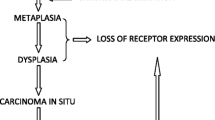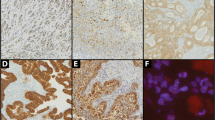Abstract
To determine whether a correlation exists between hormone receptors and their proliferative activities, the levels of estrogen receptors (ER) and progesterone receptors (PgR) in surgical specimens from 23 patients with gastric cancer and from 32 patients with colorectal cancer were investigated using an enzyme immunoassay. These values were examined in relation to the parameters of cell kinetics determined by DNA flow cytometry. When the cutoff value was determined as 2.0 fmol/mg of cytosolic protein, ER and PgR were found in 13 (56%) and 6 (26%) of the 23 patients with gastric cancer, respectively, and in 10 (31%) and 10 (31%) of the 32 patients with colorectal cancer, respectively. There was a significant correlation in the expressions of ER between the cancer tissues and normal mucosa (P=0.040). Although the expressions of ER or PgR were apparently not related to pathological status, better correlations of hormone receptor-negative tumors with increased hyperaneuploid levels were evident. According to a multiple regression analysis, ER levels significantly correlated with changes in the DNA index (P=0.041) and in the heterogeneity index score (HIS) (P=0.034). Thus, sex hormone receptors proved to be relevant factors associated with the proliferative activity of adenocarcinoma of the gastrointestinal tract. These findings indicate that the expression of hormone receptors provides pertinent biological information required to determine adequate therapeutic regimens in patients with gastrointestinal cancer.
Similar content being viewed by others
References
Meggouh F, Lointier P, Pezet D, Saez S (1991) Status of sex steroid hormone receptors in large bowel cancer. Cancer 67: 1964–1970
Scambia G, Panici PB, Bellantone R, Doglietto GB, Sofo L, Ferrandina G, Ratoo C, Bossola M, Crucitti F, Spagnolo LC, Mancuso S (1991) Receptors for epidermal growth factor and steroid hormones in primary colorectal tumors. J Surg Oncol 48:183–187
Hendrickse CW, Jones CE, Donovan IA, Meoptolemos JP, Baker PR (1993) Oestrogen and progesterone receptors in colorectal cancer and human colonic cancer cell lines. Br J Surg 80:636–640
Singh S, Sheppard MC, Langman MJS (1993) Sex difference in the incidence of colorectal cancer: an exploration of oestrogen and progesterone receptors. Gut 34:611–615
Wu CW, Tsay SH, Chang TJ, Chang HM, Hsieh MC, Lui WY, P'eng FK, Chi CW (1992) Clinicopathologic comparisons between estrogen receptor-positive and- negative gastric cancers. J Surg Oncol 51:231–235
Wu CW, Chang HM, Kao HL, Lui WY, P'eng FK, Chi CW (1992) The nontransformed progesterone and estrogen receptors in gastric cancer. Gastroenterology 102:1639–1646
Scott NA, Grande JP, Weiland LH, Pemberton JH, Beart RW Jr, Leiber MM (1987) Flow cytometric DNA patterns from colorectal cancers. How reproducible are they? Mayo Clin Proc 62:331–337
Bauer KD, Lincoln St, Vera-Roman JM, Wallemark CB, Chmiel JS, Madurski ML, Murad T, Scarpelli DG (1987) Prognostic implications of proliferative activity and DNA aneuploidy in colonic adenocarcinomas. Lab Invest 57:329–335
Dresseler LG, Seaamer LC, Owens MA, Clark GM, McGuire WL (1988) DNA flow cytometry and prognostic factors in 1331 frozen breast cancer specimens. Cancer 61:420–427
Paradiso A, Tommasi S, Mangia A (1990) Tumor-proliferative activity, progesterone receptor status, estrogen receptor level and clinical outcome of estrogen receptor-positive advanced breast cancer. Cancer Res 50:2958–2962
Moran R, Black M, Alppeert L (1984) Concentration of cell-cycle kinetics, hormone receptors, histopathology and model status in human breast cancer. Cancer 54:1586–1590
Raymond WA, Leong AS (1989) The relationship between growth factors and estrogen receptors in human breast carcinoma as determined by immunohistochemical staining. J Pathol 158:203–211
Korenaga D, Orita H, Maekawa S, Itasaka H, Ikeda T, Sugimachi K (1997) Relationship between hormone receptor levels and cell-kinetics in human colorectal cancer. Hepato-Gastroenterol 44:78–83
Japanese Research Society for Gastric Cancer (1981) The general rules for the gastric cancer study in surgery and pathology. Jpn J Surg 11:127–139
Borrmann R (1926) Geschcwulste des Magens und Duodenums. In: Henke F, Lubarsch O (eds) Handbuch der speziellen pathologischen Anatomie und Histologie, Vol. IV. Springer, Berlin, pp 865–1054
Mori M, Adachi Y, Nakamura K, Kuroiwa S, Enjoji M, Sugimachi K (1990) Advanced gastric carcinoma simulating early gastric carcinoma. Cancer 65:1033–1040
Watanabe H, Jass JR, Sobin LH (1990) Histopathological typing of oesophageal and gastric tumours, 2nd edn. Springer, Berlin Heidelberg New York London Paris Tokyo Hong Kong, p 23
Bradford M (1976) A rapid and sensitivie method for the quantification off microgram quantities of protein utilizing the principle of protein-dye binding. Anal Biochem 72:248–254
Taylor IW (1980) A rapid single step staining technique for DNA analysis by flow microfluorimetry. J Histochem Cytochem 28:1021–1024
Tachibana M, Choudhury M, Addonizio JC, Burson ML, Chiao JW, Nagamatsu GR (1985) Heterogeneity index score (HIS); new computerized method for classification of human bladder carcinomas using flow cytometry. Urology 26:356–361
Magnusson I, Rosen AV, Nilsson R, Macias A, Perez R, Skoog L (1989) Receptors for epidermal growth factor and sex steroid hormones in human colorectal carcinomas. Anticancer Res 9:299–302
Dawson PM, Shousha S, Blair SD, Carter GD, Jones J, Alaghband-Zadeh J, Theodorou NA (1990) Oestrogen receptors in colorectal carcinoma. J Clin Pathol 43:149–151
Tokunaga A, Nishi K, Matsukura N, Tanaka N, Onda M, Shirota A, Asano G, Hayashi K (1986) Estrogen and progesterone receptors in gastric cancer. Cancer 57:1376–1379
Harrison JD, Morris DL, Ellis IO, Jones JA, Jackson I (1989) The effect of tamoxifen and estrogen receptor status on survival in gastric carcinoma. Cancer 64:1007–1010
Norman JC, Puddefoot JR, Anderson E, Braunsberg H (1988) Relationship between polyamine, deoxyribonucleic acid and estrogen receptor binding site concentrations in human breast tumours. Eur J Cancer Clin Oncol 24:603–613
Francavilla A, Di LA, Eagon PK, Wu SQ, Ove P, van Thiel DH, Starzl TE (1984) Regenerating rat liver: correlation between estrogen receptor localization and deoxyribonucleic acid synthesis. Gastroenterology 86:552–557
May F, Johnson M, Wiseman L, Wakeling AE, Kastner P, Westley BR (1989) Regulation of progesterone receptor mRNA by oestradiol and antiestrogens in breast cancer cell lines. J Steroid Biochem 33:1035–1041
Maehara Y, Emi Y, Sakaguchi Y, Kusumoto T, Kakeji Y, Kohnoe S, Sugimachi K (1990) Estrogen-receptor-negative breast cancer tissue in chemosensitive in vitro compared with estrogen-receptor-positive tissue. Eur Surg Res 22:50–56
Allegra JC, Lippman ME, Thompsson EB, Simon R (1978) An association between steroid hormone receptors and response to cytotoxic chemotherapy in patients with metastatic breast cancer. Cancer Res 38:4299–4304
Author information
Authors and Affiliations
Additional information
This study was supported in part by a grant from the Liver and Kidney Diseases Foundation of Fukuoka City, Fukuoka, Japan
Rights and permissions
About this article
Cite this article
Korenaga, D., Orita, H., Okuyama, T. et al. Sex hormone-receptor-negative tumors have a higher proliferative activity than sex hormone-receptor-positive tumors in human adenocarcinomas of the gastrointestinal tract. Surg Today 28, 1007–1014 (1998). https://doi.org/10.1007/BF02483953
Received:
Accepted:
Issue Date:
DOI: https://doi.org/10.1007/BF02483953




